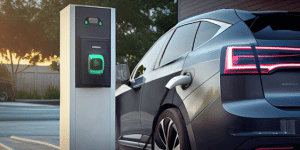Australian EV Safety Crisis: How Untested Electric Vehicles Are Bypassing Critical Safety Standards
Original Purpose and Intent of the Scheme
The Specialist and Enthusiast Vehicle Scheme was developed with a clear vision in mind: facilitating car enthusiasts to import unique vehicles, often of historical or niche significance, into Australia.
These vehicles typically include classic American hot rods, rare sports cars, and other high-performance machines that are sought after by collectors and enthusiasts alike.
The intention was to enrich the automotive community with diverse and unique vehicles that otherwise would not be available in the Australian market.
Current Misuse of the Scheme for Importing Second-Hand EVs
Despite its well-intended origins, this scheme is currently being exploited to import a growing number of second-hand electric vehicles (EVs).
This shift in the scheme’s utilization has raised several alarms as it moves away from its original purpose.
What was meant to cater to the niche interests of car enthusiasts is now a broader channel for bringing in used EVs, many of which have not undergone the same stringent safety evaluations that are required for conventional imports.
Growing Concerns from ANCAP About Scheme Exploitation
The Australasian New Car Assessment Program (ANCAP) has expressed significant concerns regarding this misuse.
ANCAP Chief Executive Carla Hoorweg has pointed out that the scheme was never intended for the bulk importation of second-hand EVs, and this shift could have dangerous repercussions.
The safety of these imported vehicles is a major concern. Because these EVs circumvent the standard safety tests, their roadworthiness remains questionable. This situation not only undermines ANCAP’s safety ratings but also poses a real risk to the public.
Reviewing and reforming the scheme to ensure it aligns with its initial intent is crucial. Regulatory updates are necessary to protect consumers and maintain the integrity of the vehicle importation process in Australia.

Safety Risks of Untested EV Imports
Bypass of Mandatory Safety Testing Through the Enthusiast Loophole
Untested electric vehicles (EVs) making their way into Australia via the enthusiast vehicle loophole pose a significant safety risk.
The Specialist and Enthusiast Vehicle Scheme permits individuals or small batches of vehicles to be imported without undergoing the stringent safety tests required for conventional imports.
As a result, these vehicles often bypass comprehensive safety evaluations, raising serious concerns about their roadworthiness.
Potential Dangers of Older, Untested EVs Entering Australian Roads
The regulatory framework, originally designed to facilitate the import of unique and historical vehicles, is now being bypassed to bring in a larger quantity of untested EVs. This misuse has prompted serious safety concerns that cannot be ignored.
Many of the EVs imported through this loophole are second-hand models that may not comply with contemporary safety benchmarks.
Older EVs, which might not meet current safety standards, are more prone to safety deficiencies. By bypassing standard safety assessments, there is a risk of these unsafe vehicles causing accidents or endangering the lives of drivers and passengers.
For instance, these older models could have compromised battery systems, outdated electronic stability controls, and insufficient protection in crash scenarios.
Lack of Compliance with Australian Design Rule Standards
The Australasian New Car Assessment Program (ANCAP) has voiced strong concerns regarding the lack of proper safety testing for these imported EVs.
ANCAP’s rigorous testing procedures require multiple vehicles of the same model to generate a comprehensive safety rating.
Due to the nature of the specialist and enthusiast scheme, which only allows for the import of individual vehicles or small batches, these vehicles become ineligible for the full spectrum of ANCAP’s tests.
This scheme exploitation effectively subverts ANCAP’s rating system and Australian design rule requirements. This creates a scenario where older and potentially less safe vehicles can circumvent established safety protocols, thereby posing significant risks to Australian consumers.
With the growing concerns, it is evident that stricter regulatory measures are necessary to ensure that all imported EVs comply with safety standards, safeguarding Australian roads and maintaining market integrity.
ANCAP’s Testing Challenges
ANCAP’s extensive crash test protocols further underscore the need for rigorous safety evaluations.
Understanding these challenges helps illustrate the importance of re-examining the scheme to prevent further misuse.
ANCAP’s Testing Challenges
Requirement of Multiple Identical Vehicles for Comprehensive Safety Testing
One of the fundamental hurdles that ANCAP faces stems from its need to test multiple identical vehicles thoroughly.
For comprehensive safety evaluations, ANCAP requires at least four identical production models to destroy.
This stringent approach guarantees that every critical aspect of a vehicle’s safety can be scrutinized under various crash scenarios.
The costly and meticulous process allows for a complete and reliable assessment of how well a vehicle protects its occupants.
Impossibility of Properly Testing Individually Imported Vehicles
The nature of the specialist and enthusiast vehicle scheme, which allows for the importation of individual or small batches of vehicles, means there is no mandate to acquire multiple identical models for testing.
As a result, these vehicles escape the crucial safety checks they would otherwise undergo if imported through conventional means. Without these comprehensive evaluations, potentially unsafe EVs can make it onto Australian roads, posing significant risks to consumers.
Understanding ANCAP’s Rigorous Crash Test Protocols
ANCAP’s rigorous crash test protocols are the gold standard for vehicle safety.
Each test, whether a head-on collision, a side-impact crash, or a roll-over test, assesses different critical areas of a vehicle’s structure and safety systems. These procedures ensure the vehicle meets high safety standards and is safe for public roads.
Maintaining the rigorous nature of ANCAP’s crash test protocols is crucial.
This involves assessing different scenarios and ensuring results are comprehensive and reliable.
The ongoing challenges highlight the importance of adapting regulations to ensure every EV, regardless of its import route, meets these stringent safety standards.
Addressing these testing challenges is vital for upholding consumer trust and ensuring the safe adoption of electric vehicles in Australia.
Regulatory Oversight and Transparency Issues
Role of the Department of Infrastructure and Transport
The Department of Infrastructure and Transport is tasked with managing the specialist and enthusiast car scheme.
Originally, this scheme was crafted to allow the import of unique, historical, or high-performance vehicles into Australia.
However, this well-intentioned framework is currently being misused to import second-hand electric vehicles (EVs), raising significant safety concerns.
The department now faces the challenge of regulating vehicles that bypass standard safety tests, undermining the rigorous safety protocols established by ANCAP.
The loophole within this scheme allows for the importation of individual vehicles or small batches, which do not adhere to the stringent safety checks required for conventional imports.
This creates a regulatory oversight issue, highlighting the need for tighter controls and enforcement to ensure public safety.
Lack of Public Data on Imported EVs
Transparency is crucial for effective oversight. Unfortunately, there is a lack of public data regarding the number of EVs imported through the specialist and enthusiast scheme.
This data, while likely held by the Department of Infrastructure and Transport, is not readily accessible to the public, as noted by ANCAP CEO Carla Hoorweg.
The absence of accessible data creates a blind spot for regulators and consumers alike, making it difficult to fully grasp the extent of the problem and implement necessary safeguards.
Without this transparency, it remains challenging to ensure all imported vehicles meet Australia’s stringent safety standards.
The lack of publicly available data on these imports prevents a complete understanding of the risks and hinders effective regulatory action.
Challenges in Monitoring and Regulating Individual Imports
Monitoring and regulating individually imported vehicles pose significant challenges.
The nature of the specialist and enthusiast scheme allows for these one-off or small batch imports, bypassing ANCAP’s safety checks, which require multiple identical vehicles to conduct thorough testing.
This system, designed to facilitate the import of genuinely unique or historic vehicles, is not equipped to handle the increasing volume of second-hand EVs being brought into the country.
The Department of Infrastructure and Transport must therefore adapt its regulatory framework to better track and manage these imports.
Improving the transparency and oversight mechanisms will be essential in preventing misuse of the scheme and ensuring that all vehicles on Australian roads meet the necessary safety standards.
To address these regulatory and transparency issues, policymakers and stakeholders need to work together to revise and strengthen the oversight mechanisms of the specialist and enthusiast car scheme, ultimately safeguarding consumer safety.
The Truth About EV Safety Standards
ANCAP’s Extensive Testing of Over 90 EVs and Hybrids
The Australasian New Car Assessment Program (ANCAP) has been a pillar in ensuring vehicle safety, having tested and rated over 90 electric vehicles (EVs) and hybrids, which is a testament to their commitment to public safety.
These tests cover vehicles across various categories and manufacturers, providing a comprehensive view of EV performance and safety.
Contrary to some claims, properly tested EVs have demonstrated safety ratings on par with traditional internal combustion engine vehicles, with many EVs achieving four or five-star ratings [Safety Concerns].
Debunking Common Misconceptions About EV Safety
One prevalent misconception is that EVs are inherently prone to battery fires.
However, ANCAP’s rigorous testing procedures have not recorded any incidents of battery-related fires, debunking this myth.
The meticulous tests are designed to assess the integrity of battery systems under various conditions, including crashes.
These tests have shown that modern EVs are incredibly resilient and safe, offering considerable protection to occupants.
Actual Safety Performance of Properly Tested Electric Vehicles
The true safety performance of EVs shines through rigorous and standardized testing.
When EVs undergo ANCAP’s thorough evaluations, they are subjected to multiple crashes and detailed inspections.
This ensures that all aspects of the vehicle’s safety features, including structural integrity and occupant protection, are comprehensively assessed.
Consequently, EVs subjected to these tests have shown robust safety profiles, reinforcing that properly evaluated EVs are as safe as their traditional counterparts.
As we continue to embrace EV technology, maintaining reliable safety standards is crucial for consumer trust and widespread adoption.
This emphasizes the importance of rigorous oversight and regular updates to safety regulations, ensuring that all imported vehicles, including those under specialized schemes, meet stringent safety criteria.
Call for Reform and Future Solutions
Proposed Changes to Strengthen Import Regulations and Safety Standards
To address the significant misuse of the Specialist and Enthusiast Vehicle Scheme and reinforce vehicle safety on Australian roads, there is a growing call for regulatory reform.
Primarily, the scheme must revert to its original intent—facilitating the import of genuinely unique or historical vehicles, rather than second-hand EVs. Potential changes include:
-
🚗 Revising import criteria to ensure that only genuinely unique or historical vehicles are eligible.
-
🔒 Strengthening oversight mechanisms to prevent misuse.
-
🔧 Mandating that all imported EVs undergo ANCAP’s comprehensive safety testing before approval.
Implementing these steps is crucial in restoring the scheme’s integrity and safeguarding Australian consumers from potential hazards posed by untested vehicles.
Need for Updated Criteria to Maintain Scheme Integrity
Given the evolving automotive landscape, updating criteria for vehicle imports is essential to maintain the integrity of the scheme.
A thorough review should focus on:
-
🔍 Ensuring transparently enforced eligibility criteria for imported vehicles.
-
📜 Establishing a clear and rigorous process for evaluating the uniqueness and historical value of vehicles.
-
📊 Enhancing data transparency to allow better monitoring and regulation of imported vehicles.
Balancing EV Adoption with Consumer Safety Concerns
As Australia progresses towards wider EV adoption, it’s vital to balance this transition with robust consumer safety standards.
This involves:
| 🔧 Strategy | 💡 Description |
|---|---|
| ⚖️ Adapting Regulations | Adjust regulations to ease EV adoption while ensuring strict safety compliance. |
| ⚡ Charging Infrastructure | Promote the development of widespread charging stations to support EV growth. |
| 🤝 Sector Collaboration | Collaborate with the automotive and energy sectors to ensure a smooth and safe transition to electric mobility. |
Ensuring consumer safety through rigorous vehicle testing and transparent regulations will build trust in EV technology, facilitating its broader acceptance.
By addressing these regulatory and safety challenges, Australia can pave the way for a safer, more efficient transition towards an electrified future.






